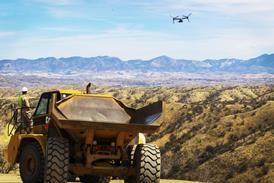GRAHAM WARWICK / WASHINGTON DC
Debris was coming off the Space Shuttle Columbia as it crossed the California coast, more than 6min before the orbiter broke up over Texas, investigators confirm. Analysis of images of the re-entry suggests the parts were small and may not have survived re-entry, says Columbia accident investigation board member James Hallock.
The first unusual telemetry indication was received while Columbia was above the Pacific, just over 7min before the vehicle broke up during re-entry on 1 February. Trajectory analysis is under way in a bid to locate early debris in southern California and northern Arizona.
The board believes a breach in the thermal-protection system allowed superhot plasma to enter the left wing. According to the latest timeline, Columbia had just entered the region of peak re-entry heating when the first temperature rises were recorded in the left main landing gear (MLG) wheel well (all times GMT):
13.44.09 Entry interface: height 395,010ft; speed Mach 24.56
13.50.53 Start of peak heating region (243,048ft, M24.12)
13.52.17 Unusual temperature rise on left MLG brake line sensor on wheel well inboard sidewall (236,791ft, M23.58)
13.52.41 Unusual temperature rise on two brake line sensors, one on strut facing MLG door (234,928ft; M23.4)
13.52.59-13.53.36 Over 37s, five temperature sensors associated with left elevons drop off line. Sensor wiring is routed along outboard side of MLG wheel well, before crossing in front of well and into fuselage
13.53.46 Temperature rise rate on brake line sensor on strut facing left MLG door changes from 1.4°F/1min to 5.5°F/min and increases until loss of signal (230,203ft, M22.86)
13.54.10 Third left MLG brake line sensor shows unusual temperature increase (228,460ft, M22.64)
13.54.20 Start of slow aileron trim change as flight control system counteracts increasing drag on left side of the orbiter (time is approximate)
13.54.22 Two temperature sensors on fuselage side above left wing show unusual increases of 7.6°F/min (mid) and 5.5°F/min (aft)
13.54.24-13.55.12 Over 48s, three left MLG temperature sensors show unusual readings
13.55.21 Telemetry indicates increased aerodynamic drag (224,002ft, M21.92)
13.55.41 Sensor on left mid-fuselage side begins unusually high (2.6°F/min) temperature rise (222,821ft, M21.69)
13.56.03 Left lower wing-skin temperature trends down, indicating potential sensor or wiring damage (sensor drops off line at 13.57.28)
13.56.16-13.58.16 Over 2min, seven left MLG sensors show increased temperature rise rates
13.56.24 Left upper wing-skin temperature trends down, indicating potential sensor or wiring damage (sensor drops off line at 13.57.43)
13.56.30-13.56.55 Flight control system performs first of four planned roll reversals to bleed off energy
13.57.19-13.57.24 Anomalous readings from two left outboard MLG tyre pressure sensors
13.57.35 Start of roll trim on elevons (216,845ft, M20.31)
13.58.03 Start of "sharp" aileron trim increase (time is approximate)
13.58.32-13.58.54 Over 22s, left MLG tyre pressure and wheel temperature sensors drop off line
13.58.39-13.58.56 Columbia's back-up computer alerts crew to loss of tyre pressure data
13.59.06 Downlock sensor indicates left MLG deployed, but uplock sensor indicates no change. NASA says downlock indication was erroneous (204,336ft, M18.68)
13.59.30 Two right yaw thrusters fire to help elevons keep orbiter on course (200,767ft, M18.16)
13.59.31 Maximum observed elevon deflection: left up 8.11°, right up 1.15°
13.59.32 Maximum observed aileron trim (-2.3°). Loss of all signals
NASA has recovered an extra 5s of data received following loss of communication with the orbiter. This shows the third and fourth yaw thrusters firing as the flight control system struggled to counteract increasing drag on the left side.
Source: Flight International























